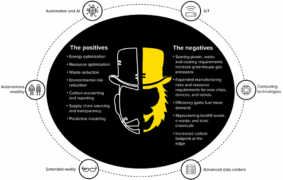Tradeoffs. The world of tech is full of them. Yet, as Forrester Research points out in a recent trends report, tradeoffs can give disruptive technologies a Jekyll and Hyde personality, providing great benefits but at the same time undermining an organization’s sustainability efforts.
“Disruptive technologies are a double-edged sword for environmental sustainability, offering both crucial enablers and significant challenges,” explained the 15-page report written by Abhijit Sunil, Paul Miller, Craig Le Clair, Renee Taylor-Huot, Michele Pelino, with Amy DeMartine, Danielle Chittem, and Peter Harrison.
“On the positive side,” it continued, “technology innovations accelerate energy and resource efficiency, aid in climate adaptation and risk mitigation, monitor crucial sustainability metrics, and even help in environmental conservation.”
“However,” it added, “the necessary compute power, volume of waste, types of materials needed, and scale of implementing these technologies can offset their benefits.”
Disruptive tech can be a balancing act, noted Mark N. Vena, president and principal analyst for SmartTech Research, in Las Vegas.
“These technologies can be incredible accelerators for sustainable outcomes, but without careful planning, they can quietly undermine the very goals they’re meant to support,” he told TechNewsWorld. “The companies that will get this right are the ones treating sustainability as a measurable performance metric alongside revenue and productivity, and holding themselves accountable for both sides of the equation.”
“Often when a new technology like AI hits the market, it carries with it a lot of consequential damages that weren’t fully anticipated,” added Rob Enderle, president and principal analyst with the Enderle Group, an advisory services firm in Bend, Ore.
“Not only is the technology far more damaging than anticipated,” he told TechNewsWorld, “but it also carries within it methodologies, such as AI modeling and simulation, that could massively reduce that impact, if properly used.”
6 Disruptive Technologies That Can Be Good and Bad for Environmental Sustainability
Image reproduced with permission. Copyright Forrester Research, Inc.
AI’s Sustainability Tradeoffs
One Jekyll and Hyde disruptor identified by Forrester is automation and AI. Those technologies, the report noted, can boost sustainability through efficiency and environmental monitoring but risk increasing energy use, inefficiencies, and challenges like data security and AI unpredictability.
Forrester’s Sunil maintained that efficient computing is key to sustainable AI. He cited an Nvidia study that found energy-efficient hardware, such as GPUs, can reduce energy use by as much as 10 times and decrease capital costs by six times, while increasing performance by up to 46 times.
“To meet sustainability goals with automation and AI,” he told TechNewsWorld, “one of our recommendations is to develop proofs of concept for ‘stewardship agents’ and explore emerging robotics focused on sustainability.”
When planning AI operations, Franklin Manchester, a principal global industry advisor at SAS, an analytics and artificial intelligence software company in Cary, N.C., cautioned, “Not every nut needs to be cracked with a sledgehammer.”
“Start with good processes — think lean process mapping, for example — and deploy AI where it makes sense to do so,” he told TechNewsWorld.
“Augment what your talented humans already do with AI tools to supplement their expertise,” he continued. “Scale modeling and cloud usage to fit your needs and streamline costs. This reduces the burden on the overall system.”
Sustainable Data Center Strategies
Manchester also recommended that businesses invest in boring projects. “Did you know we put a man on the moon before we thought to put wheels on luggage?” he asked. “Put wheels on luggage. You don’t need a moonshot AI use case to save dollars. In the end, being strategic about where we apply AI will help reduce the burden on finite resources, promoting sustainability while also helping economize costs.”
Forrester also identified state-of-the-art data centers as double-edged sword technology. Advanced data centers boost AI efficiency with technologies like liquid cooling, heat reuse, and modular design, the report noted, but risk higher energy demand, e-waste, and reliance on scarce materials.
A sustainable data center strategy needs to be driven by investments in energy-efficient infrastructure, exploring renewable energy options like power purchase agreements and microgrids, and extending IT lifecycles through modular, repairable equipment, Forrester’s Sunil maintained.
“The adoption of circular economy principles plays a big role here,” he continued. “For data center operators, this means choosing infrastructure equipment that is durable, modular, and easy to repair or upgrade, as well as planning for responsible disposal or reuse.”
Vena argued that advanced data centers can be part of the sustainability solution, but only if efficiency improvements, like liquid cooling and heat reuse, are paired with a genuine commitment to renewable energy sourcing.
“We also need better supply chain accountability for the rare materials in servers and networking gear, and stronger recycling programs for retired equipment,” he added. “The same ingenuity that’s going into AI optimization should be applied to extending hardware life.”
Sustainability in Autonomous Mobility
Another disruptor in the report: autonomous mobility.
Autonomous mobility optimizes transport efficiency with drones, delivery robots, and truck platoons, but risks increased vehicle proliferation and resource strain due to reduced operational costs, the report noted.
Human drivers are a significant cost in transportation systems, and removing that cost may have unintended consequences, the report explained. If it’s cheaper to build and operate a fleet of driverless delivery trucks, those trucks may proliferate on roads, consuming more resources in their construction and operation and placing more strain on highway infrastructure, which then must be maintained and upgraded.
“I think the way to reduce those risks is to ensure autonomous mobility is deployed as part of an integrated transportation plan, rather than as a stand-alone cost-cutting measure,” Vena said. “If drones, delivery robots, and truck platoons are coordinated through shared logistics networks, we can avoid unnecessary duplication of vehicles and routes.”
“Policies that encourage vehicle sharing, regulate fleet sizes, and set sustainability targets for operators can also keep proliferation in check,” he added.
“On the resource side,” he continued, “designing these vehicles for modular repair, component reuse, and eventual recycling helps minimize the material footprint. The real opportunity is in using autonomy to move fewer vehicles more intelligently, not just more vehicles more cheaply.”
IoT’s Environmental Impact
The Internet of Things (IoT) is another disruptor cited in the Forrester report. The IoT improves sustainability through monitoring and optimization, it noted, but risks increasing e-waste, carbon footprints, and battery disposal challenges.
Vena asserted that the IoT industry must embrace longer product lifecycles with modular, upgradable designs. “If a device’s sensors or connectivity chips can be swapped out without replacing the whole unit, that cuts down on waste,” he explained. “Standardizing charging and battery formats could also help with recycling.”
“We also need stronger manufacturer take-back programs and more aggressive use of low-power wireless standards so devices last longer on a single battery,” he added.
Sunil agreed. “A big part of addressing this would be to work around the circular economy — addressing the longevity, reparability, and reusability of devices, which are elements for the circular economy,” he said.
He added that many solutions for problems created by disruptive technology draw on this framework’s emphasis on longevity, reparability, and reusability. “Considering the entire IT lifecycle is a critical aspect of making devices and infrastructure more sustainable, as most of the risks are driven by high turnover of devices and the increased need for more optimized infrastructure,” he said.
Source: technewsworld.com


